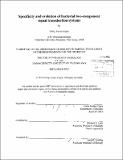| dc.contributor.advisor | Michael T. Laub. | en_US |
| dc.contributor.author | Capra, Emily Jordan | en_US |
| dc.contributor.other | Massachusetts Institute of Technology. Department of Biology. | en_US |
| dc.date.accessioned | 2014-01-09T19:52:40Z | |
| dc.date.available | 2014-01-09T19:52:40Z | |
| dc.date.issued | 2013 | en_US |
| dc.identifier.uri | http://hdl.handle.net/1721.1/83765 | |
| dc.description | Thesis (Ph. D.)--Massachusetts Institute of Technology, Dept. of Biology, 2013. | en_US |
| dc.description | Cataloged from PDF version of thesis. | en_US |
| dc.description | Includes bibliographical references. | en_US |
| dc.description.abstract | Cells possess a remarkable capacity to sense and process a diverse range of signals. Duplication and divergence of a relatively small number of gene families has provided the raw material enabling cells to quickly increase their signaling capacity. After duplication, however, all pathway components are identical in sequence and function. To evolve a new role, the pathways must become insulated at the level of signal transduction. Two-component signal transduction systems, consisting of a sensor histidine kinase and a cognate response regulator, are the main means by which bacteria sense and respond to their environment. These systems have undergone extensive duplication and lateral gene transfer such that most species encode dozens to hundreds of these pathways, yet there is little evidence of cross-talk at the level of signal transduction. Previous work has shown that interaction specificity is dictated by molecular recognition and determined by a small set of specificity residues. I begin by studying the evolutionary trajectories of specificity residues in a duplicated two-component system that lead to insulation of pathways while at the same time maintaining interaction between cognate kinases and regulators. I then examine specificity residues in orthologs of a single two-component system and show that specificity residues are typically under purifying selection, but, as a result of additions to the two-component signaling network, can undergo bursts of diversification followed by extended stasis. By reversing these mutations I demonstrate that avoidance of cross-talk is a major selective pressure. Finally, I show that covalent attachment of the response regulator to a kinase represents an alternative mechanism for enforcing specificity. In these cases, no changes are needed to accommodate a duplication; the high effective concentration of the covalently attached response regulator prevents cross-talk with other two component proteins in the cell. This may allow hybrid kinases to be duplicated or transferred between genomes more easily. This work sheds light on the apparent ease with which two-component systems have expanded to become the dominant signaling system in bacterial genomes and, more generally, how a small number of gene families can be responsible for signal transduction in all organisms. | en_US |
| dc.description.statementofresponsibility | by Emily Jordan Capra. | en_US |
| dc.format.extent | 198 pages | en_US |
| dc.language.iso | eng | en_US |
| dc.publisher | Massachusetts Institute of Technology | en_US |
| dc.rights | M.I.T. theses are protected by
copyright. They may be viewed from this source for any purpose, but
reproduction or distribution in any format is prohibited without written
permission. See provided URL for inquiries about permission. | en_US |
| dc.rights.uri | http://dspace.mit.edu/handle/1721.1/7582 | en_US |
| dc.subject | Biology. | en_US |
| dc.title | Specificity and evolution of bacterial two-component signal transduction systems | en_US |
| dc.type | Thesis | en_US |
| dc.description.degree | Ph.D. | en_US |
| dc.contributor.department | Massachusetts Institute of Technology. Department of Biology | |
| dc.identifier.oclc | 864878209 | en_US |
